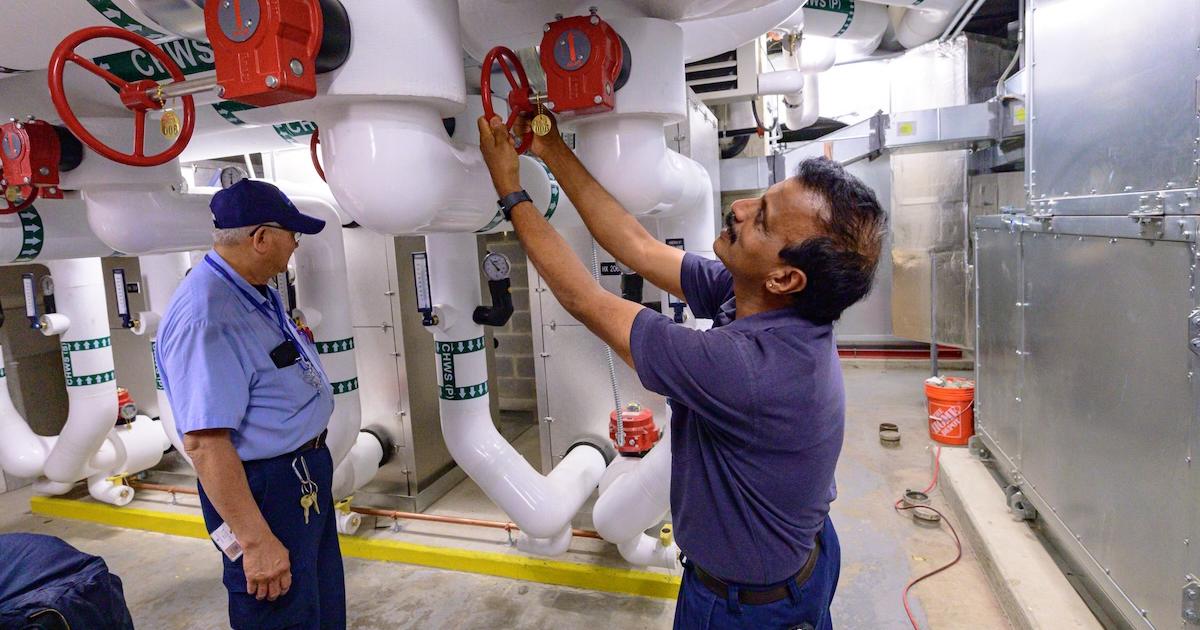Keeping Campus Comfortable is a Cool Job

American University faculty, staff, and students may have noticed colder air pumping into campus buildings recently.
Last week, Facilities Management completed the spring campus switchover from heat to cooling. Twice per year, a massive and important effort ensures residence halls remain cozy for students, temperature-sensitive research continues in laboratories, and faculty and staff have comfortable office spaces—no matter if it’s January or July.
“Unlike a home thermostat, our systems can’t just flip between heating and cooling depending on temperature swings,” David Osborne, director of energy and engineering, said. “Each switchover is a large and coordinated effort involving multiple teams and thousands of different systems, some more sophisticated than others, and each featuring varying levels of automation depending on their age, design, and technologies.”
While thousands of people navigate campus above ground, an intricate system of pipes below them is responsible for regulating temperatures in 45 campus buildings.
During the cold months, the Asbury Central Plant, the university’s cogeneration plant, converts natural gas into hot water. That 150-degree water is then pumped into a hot water loop at a flow rate of 1,400 gallons per minute—a speed that could fill a swimming pool in about five minutes. That hot water loop warms buildings, keeping temperatures between 68 and 72 degrees.
In fiscal year 2024, the Asbury microturbine generated 7,300 megawatt hours of electricity—enough to power about 1,000 homes in the DC area.
“All the power we do generate is used on campus to reduce our purchase of power from the electrical grid,” Freedman said. “We also recovered about 40 percent of the energy input that was used to make the electricity as heat into the campus hot water system.”
With winter in the rearview mirror and 90-degree days on the horizon, operations have transitioned from heat to a parallel chilled water loop that sends 45-degree water from 10 chillers to buildings.
On April 21, Facilities commissioned a new chilled water system in the basement of McDowell Hall that will help cool Leonard and Hughes. A second system installed in Anderson will provide cooling to its home building, Letts, Centennial, and McCabe halls.
“This project is something people don’t see, but it makes every day a little bit better and more efficient,” said Christopher Fuentes, the project manager who oversaw the chilled water system project.
The chilled water loop pumps water into buildings below ground. That cold water is then sent through pipes up to air handlers—usually located on top of buildings—that circulate cold air throughout the building, keeping temperatures between 74 and 78 degrees.
From a control room in the Asbury Central Plant, facilities staff monitor campus temperatures 24 hours per day, 365 days per year. A wall of screens allows them to track how efficiently the system is running—down to reading the temperature in a single room on campus.
Sixteen engineers who work around-the-clock can make many changes digitally from the control room. The massive amount of data at their disposal also helps to diagnose a problem before HVAC techs, plumbers, electricians, or engineers respond on-site.
“If there’s something that cannot get done from the control room, I communicate with them about how to get it fixed,” said lead engineer Kenny Tran, who has worked at AU for 10 years.
No matter the season, the roughly 60 facilities staff who work year-round to regulate campus temperatures are proud to serve the AU community.
“We recognize we’re not the reason you’re here,” Freedman said. “You’re the reason we’re here.”